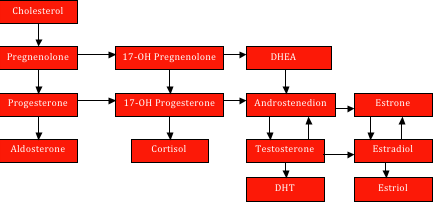The sex hormones are typically broken up into two main groups: the “male” sex hormones and the “female” sex hormones, although both types of sex hormones are present in each gender, albeit at different levels. The main hormones in each group are:
“Male” Sex Hormones:
- Androstenedione
- Dehydroepiandrosterone (DHEA)
- Dihydrotestosterone (DHT)
- Testosterone
“Female” Sex Hormones:
- Estrogens:
- Estradiol
- Estriol
- Estrone
- Progesterone
All of these hormones are made from cholesterol, proteins and essential fatty acids. The following chart illustrates how sex hormones are synthesized in the body.
One can easily see how imbalances in one of these hormones can quickly translate into imbalances in many others. This illustrates a key point in understanding the complexity of hormone balance: ALL of your hormones impact one another.
If we are going to rebalance your sex hormones, we have to take into account how other factors, such as stress (which affects cortisol and DHEA) and sleep (which affects cortisol, DHEA and testosterone) impact your overall hormone balance. Likewise, we don’t want to correct one problem, say for instance by taking DHEA, only to create others, such as imbalances between estrogen and progesterone. To successfully correct sex hormone imbalances, we have to keep the figure above in mind and look at the whole picture.



